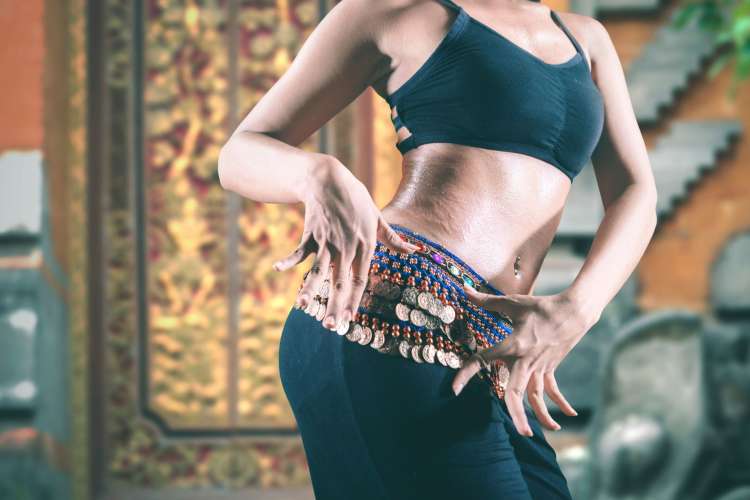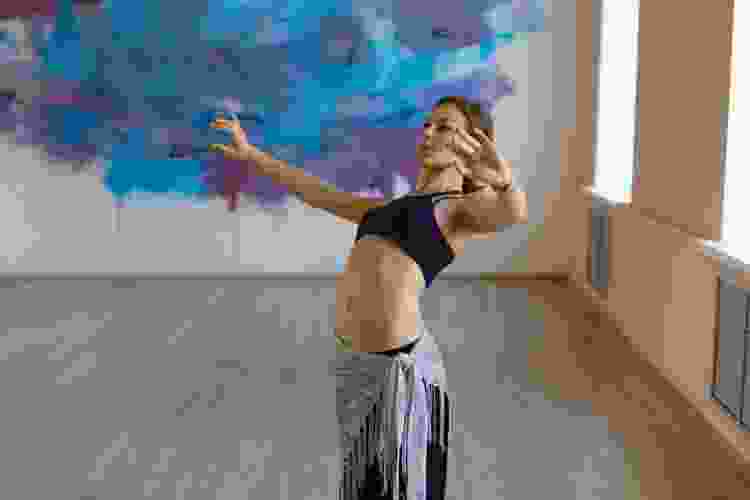How to Belly Dance in 2025: Step-by-Step Moves for Beginners

If you’ve been curious about how to belly dance, you’re in for more than just a new hobby. Learning how to belly dance connects you to your body in a unique way, helping build strength, confidence and flexibility. TikTok has helped spark a new wave of interest, with videos tagged #bellydance routinely pulling in hundreds of thousands of views and turning it into one of today’s most-watched dance trends.
If you’re curious to try something new, get moving, or connect with a rich history of dance, belly dancing is a rewarding way to do it.
Jump to Section
- How to Belly Dance for Beginners
- How to Belly Dance: Moves List
- Egyptian Belly Dance Styles That Started It All
- How to Belly Dance FAQs
How to Belly Dance for Beginners
Starting out with belly dance isn’t about getting it perfect. It’s about tuning into your body and getting comfortable with how it moves. The foundation of belly dancing is isolation: training your muscles to move independently, especially in your hips, chest and shoulders. That control takes time, but even learning the basics feels empowering.
Try Belly Dance Classes

One of the best ways to begin is with a class. A good teacher will break down the mechanics in a way that’s easy to follow and help you avoid posture habits that can throw off your form. If you’re looking to learn how to belly dance step by step, taking online dance classes or trying dance classes in NYC, Las Vegas, Orlando or dance classes near you is a great place to start.
As you get into the rhythm, traditional belly dance music can help shape your timing and make each move feel more expressive. It also creates a stronger connection between you and the dance. And loving the music is a key part of why so many people fall in love with belly dancing itself.
How to Belly Dance: Moves List
When you're learning how to belly dance, there are five foundational moves that will make up the bulk of your early practice. If you can nail these moves, you can nail how to belly dance.
Hip Lifts

One side at a time, you’ll lift your hip with control while the rest of your body stays grounded. It’s simple, but it sets the rhythm and you’ll use this move constantly as you build up to more complex combos.
Shimmies
This is the one that feels like magic once you get it. A fast, controlled shake of your hips (or sometimes shoulders) that adds texture and energy to your dance. It’s fun, it’s flashy, and it’s a workout.
Belly Rolls
A slow, wave-like motion that rolls through your abdominal muscles from top to bottom. Think of it as a core massage in motion. It's a smooth, controlled motion that's kind of mesmerizing once it clicks.
Figure Eights

Your hips draw the shape of an “8” in the air, either side to side or up and down. It’s all about flow and flexibility, and once you get the feel for it, it takes your belly dancing to a whole new level.
Layered Isolations
This is where it gets creative. You’ll stack one move on top of another — like adding a shimmy to a figure eight — to create combos that feel expressive and personal. Layering is where your dancing really starts to feel like you.
These movements form the building blocks of belly dancing. As you get more comfortable, you’ll start linking them together into mesmerizing routines. Practicing with traditional belly dance music can also help you lock into the rhythm and express the dance more intuitively.
Egyptian Belly Dance Styles That Started It All

As belly dance evolved across regions and generations, one style in particular shaped how the dance is practiced today — Egyptian belly dance.
Known as raqs sharqi in Arabic, this form is the most widely taught in the West. It’s typically performed solo and focuses on artistic, expressive movement. Egyptian films made in Cairo, often called Egypt’s Hollywood, helped bring this style to the global stage, with dancers like Samia Gamal and Tahia Carioca turning the look and feel of Egyptian belly dance into worldwide icons. The sequined costumes and flowing skirts they wore still influence belly dance fashion today.
But Egypt’s dance scene is broader than just raqs sharqi. Social styles like beledi and shaabi are staples at weddings and celebrations, while folk dances like melaya leff bring storytelling and props like canes, scarves or veils into the mix. Some styles are faster-paced, drawing from Turkish influences, while others feature graceful, ballet-like movement.
No matter the variation, music is central. Traditional belly dance music guides the dancer’s pace, flow and emotional tone. Today’s instructors often blend these Egyptian elements into their teaching, guiding the dancers’ movements to enhance the cultural storytelling.
How to Belly Dance FAQs
What is Belly Dancing?

At its core, belly dancing is about controlled, expressive movement, especially in the hips, torso and shoulders. It has roots in traditions from the Middle East and North Africa, where it began as a social and celebratory dance. Dancers often perform barefoot, wearing flowing costumes and using props like finger cymbals or veils to bring the music to life.
Forget the tired clichés. Belly dancing wasn’t created to be seductive. It was a way for people, especially women, to connect, celebrate and express themselves. Today, it’s still part of weddings (depending on your wedding theme, it can be a good entertainment choice), festivals and cultural events around the world, and it continues to empower people through rhythm and movement.
What Was the Original Purpose of Belly Dancing?
Belly dancing is widely believed to have started as a ritual honoring fertility, femininity and the divine. Ancient depictions of abdominal movement appear in Egyptian tombs, Greek sculpture and Mediterranean cave paintings, suggesting its roots stretch across many early cultures.
One story that surfaces again and again is the myth of Ishtar, the Babylonian goddess of love. To rescue her husband from the underworld, she dances through seven gates, shedding a veil and a jewel at each one. Her journey represents rebirth, emotional strength and the power of movement as a form of transformation. Despite the trials of her journey, Ishtar triumphs, returning with her seven veils to a bountiful homecoming.
When Did Belly Dancers Become So Popular?

Belly dancing first caught the attention of Westerners in the 18th century, when European travelers in Egypt were captivated by the dance’s fluid and expressive style. It was distinctly different from the structured fashion and formal dances of England and France. By the time it appeared at the 1893 Chicago World’s Fair, “belly dance” had a name and a curious new audience.
From there, it spread quickly through American cities, showing up on Coney Island stages and in vaudeville acts. Hollywood and international films helped shape the image we often associate with belly dance today, like glittering bras, hip belts and flowing skirts inspired by Egyptian stars.
As those Western versions made their way back to the Middle East, they began to influence the dance’s look and feel in clubs, cabarets and movies. That back-and-forth exchange helped belly dance evolve into a global art form and sparked generations of dancers to keep learning, sharing and performing it.
Why is Belly Dancing So Popular Today?

Belly dancing has become a global experience. Travelers often seek it out to connect with local culture, from catching a show in a Moroccan lounge to watching hula dancers in Hawaii (who knew you could include belly dancing with your Hawaiian party ideas?). It’s also been embraced by immigrant communities who keep their cultural traditions alive through performance, teaching and celebration.
Part of its appeal is how accessible it feels. The movements are gentle but powerful, great for building strength and confidence without high-impact movements. And that’s what has made belly dancing a go-to for people looking for a fun, expressive workout. Whether in a fitness studio, dance class or online, more people are discovering that learning how to belly dance is as enjoyable as it is empowering.
What Does Belly Dance Do for Your Body?
Like most styles of dance, belly dancing can help improve strength, posture and flexibility over time. The focus on isolating muscle groups, especially in the core, hips and legs, makes it a great way to build awareness and control in areas that often get overlooked.
Because it’s low impact, it’s also accessible to a wide range of fitness levels. Some people even practice gentle belly dance movements during pregnancy to help stay active and support abdominal strength. As with any activity, it’s best to listen to your body and adjust as needed.
What are the Psychological Benefits of Belly Dancing?
Dancing is widely linked to better mental health, and belly dancing in particular may help promote a more positive body image. The flowing, expressive movements encourage self-connection and confidence.
According to Science Daily, researchers found that “belly dancers see their own bodies in a better light... and are less likely to be dissatisfied with how they look.”
And on top of that, Psychology Today notes that creative practices like dance and music can “help lessen mental fluctuations before the onset of full depression,” while also offering social, collaborative benefits that support long-term mental health.
What are the Social Benefits of Belly Dancing?
Joining a belly dance class is about more than learning the moves. It’s a way to express yourself, connect with others and become part of a supportive, creative community. Many classes offer chances to socialize through group practices, workshops and local festivals, making it easy to build friendships along the way.
If belly dance is part of your cultural background, practicing it can be a powerful way to stay connected to those roots. And if it’s new to you, learning how to belly dance can help you appreciate both the movements and their significance to belly dancing’s native cultures.
If belly dancing has been catching your eye lately, you’re not alone. From trending videos to local classes, more people are discovering how to belly dance and loving the way it makes them feel.
Learning how to belly dance step by step isn’t just about mastering the motions. It’s about tuning in, expressing yourself and finding joy in a dance that has empowered people for generations. All you need to get started is a little curiosity and a rhythm you can move to.
For even more creative ideas and inspiration, check out other experiences happening on Classpop!

